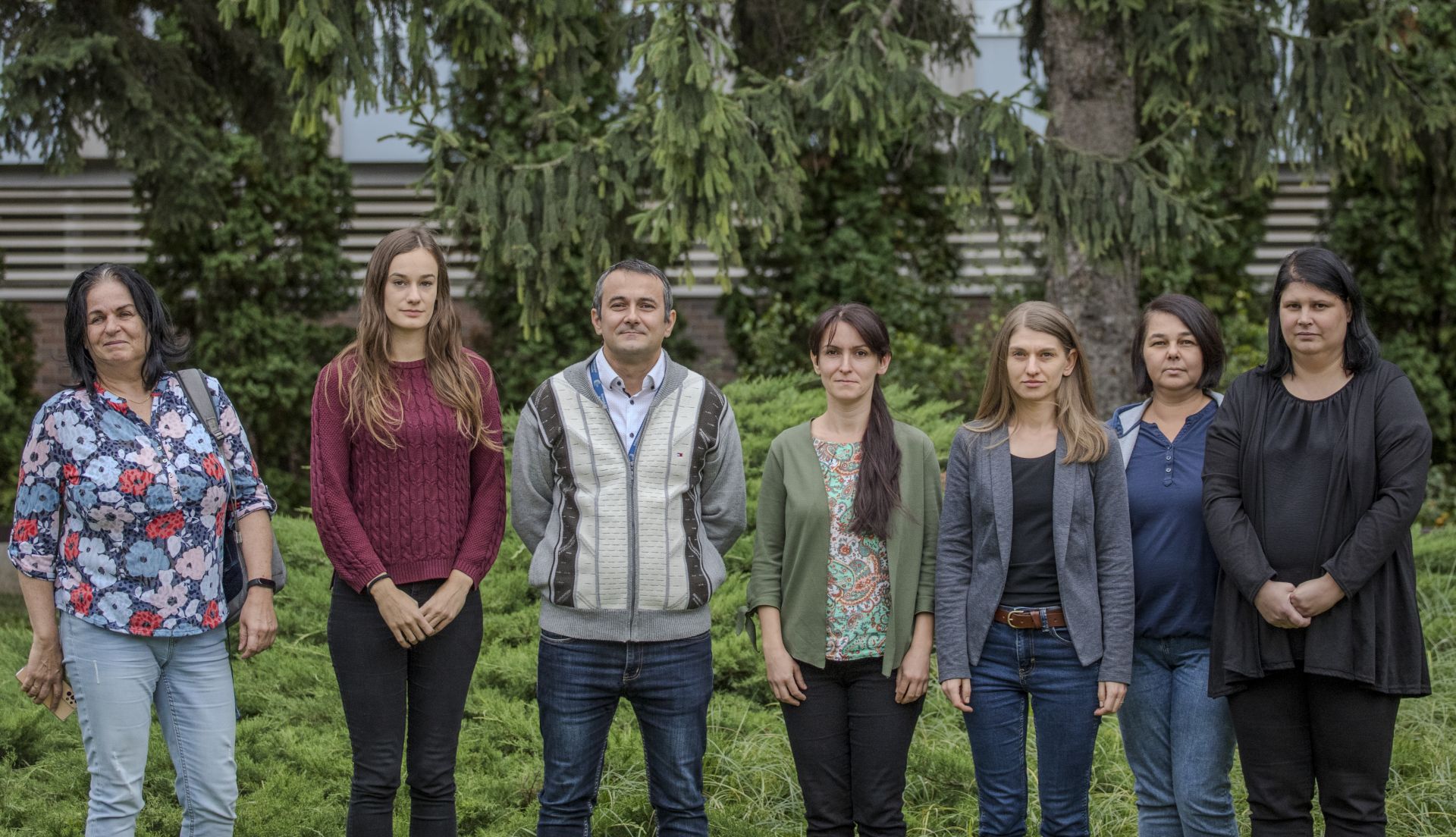Articles
Key publications
- 1. Köhler, Zoltán Márton ; Trencsényi, György ; Juhász, László ; Zvara, Ágnes ; Szabó, P Judit ; Dux, László ; Puskás, G László ; Rovó, László ; Keller-Pintér, Anikó, Tilorone increases glucose uptake in vivo and in skeletal muscle cells by enhancing Akt2/AS160 signaling and glucose transporter levels, JOURNAL OF CELLULAR PHYSIOLOGY 238 : 5 pp. 1080-1094. , 15 p. (2023)
- 2. Shukla, R.D. ; Zvara, Á. ; Avramucz, Á. ; Biketova, A.Yu. ; Nyerges, A. ; Puskás, L.G. ; Fehér, T., inPOSE: A Flexible Toolbox for Chromosomal Cloning and Amplification of Bacterial Transgenes, MICROORGANISMS 10 : 2 Paper: 236 (2022
- 3. Tóth, Melinda E. ✉ ; Sárközy, Márta* ✉ ; Szűcs, Gergő ; Dukay, Brigitta ; Hajdu, Petra ; Zvara, Ágnes ; Puskás, László G. ; Szebeni, Gábor J. ; Ruppert, Zsófia ; Csonka, Csaba et al. Exercise training worsens cardiac performance in males but does not change ejection fraction and improves hypertrophy in females in a mouse model of metabolic syndrome BIOLOGY OF SEX DIFFERENCES 13 : 1 Paper: 5 , 20 p. (2022)
- 4. Váczi, S. ; Barna, L. ; Harazin, A. ; Mészáros, M. ; Porkoláb, G. ; Zvara, Á. ; Ónody, R. ; Földesi, I. ; Veszelka, S. ; Penke, B. et al. S1R agonist modulates rat platelet eicosanoid synthesis and aggregation, PLATELETS 33 : 5 pp. 709-718. , 10 p. (2022)
- 5. Koos K, Oláh G, Balassa T, Mihut N, Rózsa M, Ozsvár A, Tasnadi E, Barzó P, Faragó N, Puskás L, Molnár G, Molnár J, Tamás G, Horvath P. Automatic deep learning-driven label-free image-guided patch clamp system. Nat Commun. 2021 Feb 10;12(1):936. doi: 10.1038/s41467-021-21291-4.
- 6. Balogh A, Reiniger L, Hetey S, Kiraly P, Toth E, Karaszi K, Juhasz K, Gelencser Z, Zvara A, Szilagyi A, Puskas LG, Matko J, Papp Z, Kovalszky I, Juhasz C, Than NG. Decreased Expression of ZNF554 in Gliomas is Associated with the Activation of Tumor Pathways and Shorter Patient Survival. Int J Mol Sci. 2020 Aug 11;21(16):5762. doi: 10.3390/ijms21165762. PMID: 32796700; PMCID: PMC7461028.
- 7. Barna L, Walter FR, Harazin A, Bocsik A, Kincses A, Tubak V, Jósvay K, Zvara Á, Campos-Bedolla P, Deli MA. Simvastatin, edaravone and dexamethasone protect against kainate-induced brain endothelial cell damage. Fluids Barriers CNS. 2020 Feb 10;17(1):5. doi: 10.1186/s12987-019-0166-1. PMID: 32036791; PMCID: PMC7008534.
- 8. Gyukity-Sebestyén E, Harmati M, Dobra G, Németh IB, Mihály J, Zvara Á, Hunyadi-Gulyás É, Katona R, Nagy I, Horváth P, Bálind Á, Szkalisity Á, Kovács M, Pankotai T, Borsos B, Erdélyi M, Szegletes Z, Veréb ZJ, Buzás EI, Kemény L, Bíró T, Buzás K. Melanoma-Derived Exosomes Induce PD-1 Overexpression and Tumor Progression via Mesenchymal Stem Cell Oncogenic Reprogramming. Front Immunol. 2019 Oct 18;10:2459. doi: 10.3389/fimmu.2019.02459. PMID: 31681332; PMCID: PMC6813737.
- 9. Bencsik P, Kiss K, Ágg B, Baán JA, Ágoston G, Varga A, Gömöri K, Mendler L, Faragó N, Zvara Á, Sántha P, Puskás LG, Jancsó G, Ferdinandy P. Sensory Neuropathy Affects Cardiac miRNA Expression Network Targeting IGF-1, SLC2a-12, EIF-4e, and ULK-2 mRNAs. Int J Mol Sci. 2019 Feb 25;20(4):991. doi: 10.3390/ijms20040991. PMID: 30823517; PMCID: PMC6412859.
- 10. Fenteany, Gabriel* ; Gaur, Paras* ; Hegedűs, Lili ; Dudás, Kata ; Kiss, Ernő ; Wéber,Edit ; Hackler, László ; Martinek, Tamás ; Puskás, László G. ; Haracska, Lajos Multilevel structure–activity proling reveals multiple green tea compound familiesthat each modulate ubiquitin-activating enzyme and ubiquitination by a distinctmechanism, SCIENTIFIC REPORTS 9 : 1 Paper: 12801 , 16 p. (2019)
- 11. Sárközy M, Gáspár R, Zvara Á, Kiscsatári L, Varga Z, Kővári B, Kovács MG, Szűcs G, Fábián G, Diószegi P, Cserni G, Puskás LG, Thum T, Kahán Z, Csont T, Bátkai S. Selective Heart Irradiation Induces Cardiac Overexpression of the Pro- hypertrophic miR-212. Front Oncol. 2019 Jul 16;9:598. doi: 10.3389/fonc.2019.00598. PMID: 31380269; PMCID: PMC6646706.
- 12. Sárközy M, Gáspár R, Zvara Á, Siska A, Kővári B, Szűcs G, Márványkövi F, Kovács MG, Diószegi P, Bodai L, Zsindely N, Pipicz M, Gömöri K, Kiss K, Bencsik P, Cserni G, Puskás LG, Földesi I, Thum T, Bátkai S, Csont T. Chronic kidney disease induces left ventricular overexpression of the pro-hypertrophic microRNA-212. Sci Rep. 2019 Feb 4;9(1):1302. doi: 10.1038/s41598-018-37690-5. PMID: 30718600; PMCID: PMC6362219.
- 13. Csajbók ÉA, Kocsis ÁK, Faragó N, Furdan S, Kovács B, Lovas S, Molnár G, Likó I, Zvara Á, Puskás LG, Patócs A, Tamás G. Expression of GLP-1 receptors in insulin-containing interneurons of rat cerebral cortex. Diabetologia. 2019 Apr;62(4):717-725. doi: 10.1007/s00125-018-4803-z. Epub 2019 Jan 12. PMID: 30637442. Intelligent image-based in situ single-cell isolation.
- 14. Brasko C, Smith K, Molnar C, Farago N, Hegedus L, Balind A, Balassa T, Szkalisity A, Sukosd F, Kocsis K, Balint B, Paavolainen L, Enyedi MZ, Nagy I, Puskas LG, Haracska L, Tamas G, Horvath P., Nat Commun. 2018 Jan 15;9(1):226. doi: 10.1038/s41467-017-02628-4.
Team
Check our Team




